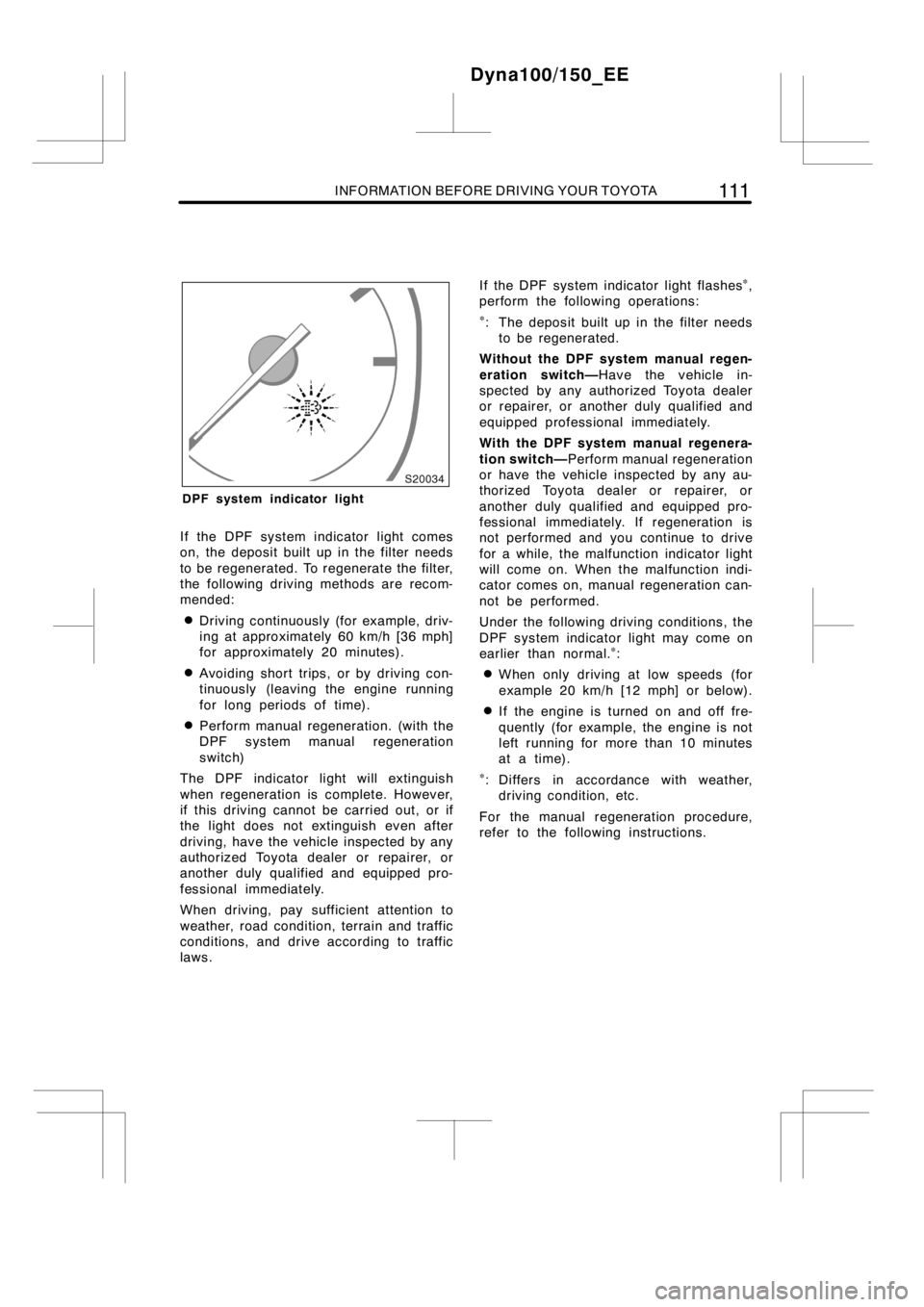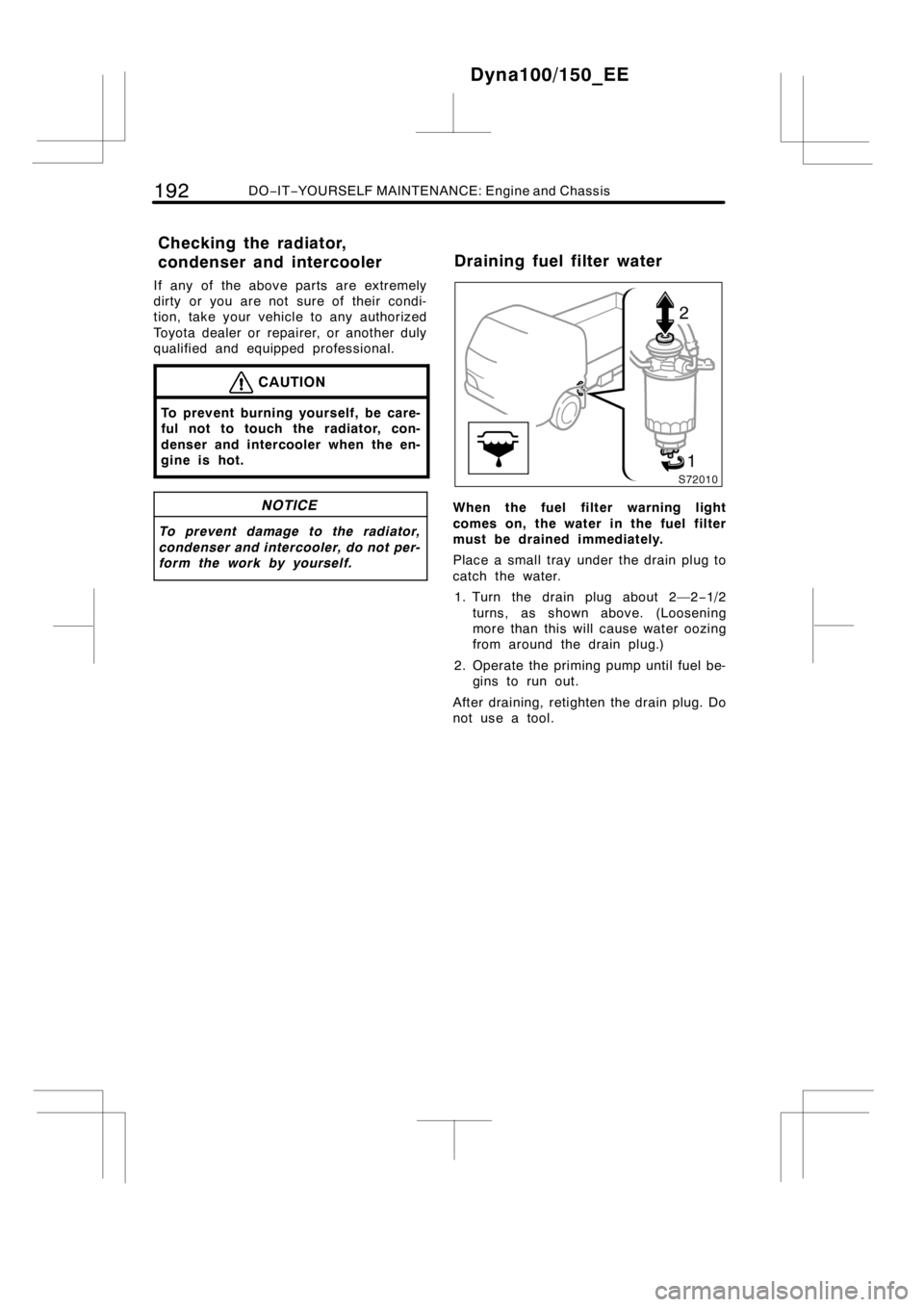Page 100 of 232
94AIR CONDITIONING SYSTEM
: Upper clips
: Lower clips
1. Before cleaning the air conditioning
filter,besuretoturnoffthefan.
Remove the front grille bolt with a
Phillips−head screwdriver. Then, re-
move the clips at the lower part of
the front grille first, and at the up-
per part next, and take off the front
grille.
NOTICE
To remove the front grille without
damaging it, pull it straight as shown
in the illustrations.
Dyna100/150_EE
—Cleaning the outside filter
Page 101 of 232
AIR CONDITIONING SYSTEM95
2. Clean the filter, which is above the
passenger ’s side headlight, with a
soft brush or cloth.
After cleaning the filter, replace the front
grille.1. Before cleaning the air conditioning
filter,besuretoturnoffthefan.
Remove the bolt and clip, and then
remove the lower cover located near
the floor on the passenger ’s side.
Dyna100/150_EE
—Cleaning the inside filter
Page 103 of 232
AIR CONDITIONING SYSTEM97
3. Pull out the filter.
After washing with a mild detergent,
rinse and dry.
After cleaning the filter, replace in reverse
order of removal.
INFORMATION
The air conditioning filter should be
installed properly. The use of air con-
ditioning system with the filter re-
moved may cause deteriorated dust-
proof performance and then affect
overall air conditioning system perfor-
mance.
Dyna100/150_EE
Page 117 of 232

INFORMATION BEFORE DRIVING YOUR TOYOTA111
DPF system indicator light
If the DPF system indicator light comes
on, the deposit built up in the filter needs
to be regenerated. To regenerate the filter,
the following driving methods are recom-
mended:
DDriving continuously (for example, driv-
ing at approximately 60 km/h [36 mph]
for approximately 20 minutes).
DAvoiding short trips, or by driving con-
tinuously (leaving the engine running
for long periods of time).
DPerform manual regeneration. (with the
DPF system manual regeneration
switch)
The DPF indicator light will extinguish
when regeneration is complete. However,
if this driving cannot be carried out, or if
the light does not extinguish even after
driving, have the vehicle inspected by any
authorized Toyota dealer or repairer, or
another duly qualified and equipped pro-
fessional immediately.
When driving, pay sufficient attention to
weather, road condition, terrain and traffic
conditions, and drive according to traffic
laws.If the DPF system indicator light flashes
�,
perform the following operations:
�: The deposit built up in the filter needs
to be regenerated.
Without the DPF system manual regen-
eration switch—Have the vehicle in-
spected by any authorized Toyota dealer
or repairer, or another duly qualified and
equipped professional immediately.
With the DPF system manual regenera-
tion switch—Perform manual regeneration
or have the vehicle inspected by any au-
thorized Toyota dealer or repairer, or
another duly qualified and equipped pro-
fessional immediately. If regeneration is
not performed and you continue to drive
for a while, the malfunction indicator light
will come on. When the malfunction indi-
cator comes on, manual regeneration can-
not be performed.
Under the following driving conditions, the
DPF system indicator light may come on
earlier than normal.
�:
DWhen only driving at low speeds (for
example 20 km/h [12 mph] or below).
DIf the engine is turned on and off fre-
quently (for example, the engine is not
left running for more than 10 minutes
at a time).
�: Differs in accordance with weather,
driving condition, etc.
For the manual regeneration procedure,
refer to the following instructions.
Dyna100/150_EE
Page 191 of 232

DO−IT−YOURSELF MAINTENANCE: Introduction185
If you perform maintenance by yourself,
be sure to follow the correct procedure
given in this Section.
You should be aware that improper or in-
complete servicing may result in operating
problems.
This Section gives instructions only for
those items that are relatively easy for an
owner to perform. As explained in Section
6, there are still a number of items that
must be done by a qualified technician
with special tools.
Utmost care should be taken when work-
ing on your vehicle to prevent accidental
injury. Here are a few precautions that
you should be especially careful to ob-
serve:
CAUTION
DWhen the engine is running, keep
hands, clothing, and tools away
from the moving fan and engine
drive belts. (Removing rings,
watches, and ties is advisable.)
DRight after driving, the engine
compartment—the engine, radiator,
exhaust manifold and power steer-
ing fluid reservoir, etc.—will be hot.
So be careful not to touch them.
Oil and fluids may also be hot.
DIf the engine is hot, do not remove
the radiator cap or loosen the drain
plugs to prevent burning yourself.
DDo not leave anything that may
burn easily, such as paper or rags,
in the engine compartment.
DDo not smoke, cause sparks or al-
low open flames around fuel or the
battery. Their fumes are flammable.
DBe extremely cautious when work-
ing on the battery. It contains poi-
sonous and corrosive sulfuric acid.
DDo not get under your vehicle with
just the body jack supporting it. Al-
ways use automotive jack stands or
other solid supports.
DBe sure that the engine switch is
off if you work near the electric
cooling fans. With the engine
switch on, the electric cooling fans
will automatically start to run if the
engine coolant temperature is high
and/or the air conditioning is on.
DUse eye protection whenever you
work on or under your vehicle
where you may be exposed to flying
or falling material, fluid spray, etc.
DUsed engine oil contains potentially
harmful contaminants which may
cause skin disorders such as in-
flammation or skin cancer, so care
should be taken to avoid prolonged
and repeated contact with it. To re-
move used engine oil from your
skin, wash thoroughly with soap
and water.
DDo not leave used oil within the
reach of children.
DDispose of used oil and filter only
in a safe and acceptable manner.
Do not dispose of used oil and fil-
ter in household trash, in sewers or
onto the ground. Call your dealer or
a service station for information
concerning recycling or disposal.
DTake care when filling the brake and
clutch fluid reservoirs because
brake fluid can harm your hands or
eyes. If fluid gets on your hands or
in your eyes, flush the affected area
with clean water immediately. If you
still feel uncomfortable with your
hands or eyes, go to the doctor.
Dyna100/150_EE
Do−it−yourself service
precautions
Page 192 of 232

186DO−IT−YOURSELF MAINTENANCE: Introduction
NOTICE
zRemember that battery cables carry
high currents. Be careful of acci-
dentally causing a short circuit.
zAdd only “Toyota Super Long Life
Coolant” or similar high quality eth-
ylene glycol based non−silicate,
non−amine, non−nitrite, and non−bo-
rate coolant with long−life hybrid
organic acid technology to fill the
radiator. “Toyota Super Long Life
Coolant” is a mixture of 50% cool-
ant and 50% deionized water.
zIf you spill some of the coolant, be
sure to wash it off with water to
prevent it from damaging the parts
or paint.
zDo not overfill power steering fluid,
or the power steering could be
damaged.
zIf you spill brake fluid, be sure to
wash it off with water to prevent it
from damaging the parts or paint.
zDo not drive with the air cleaner
filter removed, or excessive engine
wear could result.
zBe careful not to scratch the glass
surface with the wiper frame.
zWhen closing the engine access
hole cover or lowering the cab,
check to see that you have not for-
gotten any tools, rags, etc.
Dyna100/150_EE
Page 198 of 232

192DO−IT−YOURSELF MAINTENANCE: Engine and Chassis
If any of the above parts are extremely
dirty or you are not sure of their condi-
tion, take your vehicle to any authorized
Toyota dealer or repairer, or another duly
qualified and equipped professional.
CAUTION
To prevent burning yourself, be care-
ful not to touch the radiator, con-
denser and intercooler when the en-
gine is hot.
NOTICE
To prevent damage to the radiator,
condenser and intercooler, do not per-
formtheworkbyyourself.
When the fuel filter warning light
comes on, the water in the fuel filter
must be drained immediately.
Place a small tray under the drain plug to
catch the water.
1. Turn the drain plug about 2—2−1/2
turns, as shown above. (Loosening
more than this will cause water oozing
from around the drain plug.)
2. Operate the priming pump until fuel be-
gins to run out.
After draining, retighten the drain plug. Do
not use a tool.
Dyna100/150_EE
Checking the radiator,
condenser and intercoolerDraining fuel filter water
Page 222 of 232

216SPECIFICATIONS
ENGINE
Valve clearance (engine cold), mm (in.):
Intake 0.20—0.30 (0.008—0.012)
Exhaust 0.35—0.45 (0.014—0.018)
ENGINE LUBRICATION
Oil capacity (drain andrefill—reference
�),
L (qt., Imp. qt.):
With filter 7.0 (7.4, 6.2)
Without filter 6.8 (7.2, 6.0)
�: The engine oil capacity is a reference
quantity to be used when exchanging.
Warm up and turn off the engine, wait
more than 5 minutes, and check the oil
level on the dipstick.
“Toyota Genuine Motor Oil” is used in
your Toyota vehicle. Toyota recommends
the use of approved “Toyota Genuine
Motor Oil”. Another motor oil of matching
quality can also be used.
Oil grade:
ACEA C2
NOTICE
Using engine oil other than ACEA C2
may damage the catalytic converter.
Recommended viscosity (SAE):
Temperature range anticipated before
next oil change
Preferred
Please contact any authorized Toyota
dealer or repairer, or another duly quali-
fied and equipped professional, for further
details.
COOLING SYSTEM
Total capacity, L (qt., Imp. qt.):
With front and rear heaters
11.5 (12.2, 10.1)
With front heater 10.7 (11.3, 9.4)
Coolant type:
Your Toyota vehicle is filled with “Toyota
Super Long Life Coolant” at the factory.
In order to avoid technical problems,
only use “Toyota Super Long Life
Coolant” or similar high quality ethylene
glycol based non−silicate, non−amine,
non−nitrite, and non−borate coolant with
long−life hybrid organic acid technology.
(Coolant with long−life hybrid organic
acid technology is a combination of low
phosphates and organic acids.)
Do not use plain water alone.
Please contact any authorized Toyota
dealer or repairer, or another duly quali-
fied and equipped professional, for fur-
ther details.
BATTERY
Specific gravity reading at 20_C(68_F):
1.250—1.290 Fully charged
1.160—1.200 Half charged
1.060—1.100 Discharged
Charging rates:
Quick charge 15 A max.
Slow charge 5 A max.
CLUTCH
Pedal free play, mm (in.):
5—18 (0.2—0.7)
Fluid type:
SAE J1703 or FMVSS No.116 DOT 3
Dyna100/150_EE
Service specifications